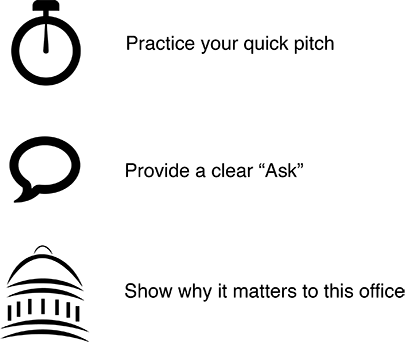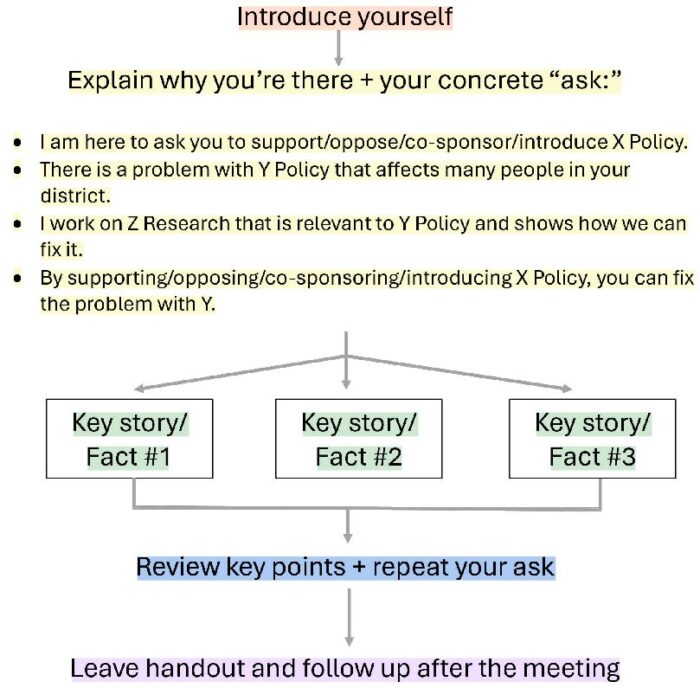Developed in collaboration with Dr. Dan Pomeroy, manager of MIT’s International Policy Lab.
Criteria for success

- Get staffer or elected official interested in your idea by showing how it relates to their voters or existing policy priorities.
- Give staffer or elected official a concrete reason for why their office should care: how it affects their constituents, their core policy interests, or the nation as a whole.
- Make a clear and specific ask for what you want them to do as soon as they leave that meeting.
Purpose
Hill meetings are not the same as meetings in academia. You will typically meet with a congressional staffer who meets with constituents, lobbyists, and various special interests all day. Each staffer covers a broad portfolio of policy issues. For example, one staffer may cover all issues related to education, science & technology, and agriculture. Therefore, they are rarely an expert in any one area, but rather have the ability to learn any area very quickly. Also, they typically do not have time to develop policy solutions themselves. Instead, they act as a filter for requests to a Congress member, deciding which recommendations are worth passing on to their boss.
You will typically meet for 15-30 minutes in a small space in their office. However, as things can get hectic in DC, you may end up meeting in a hallway or room that has some traffic. They may also be distracted by emails or other people in the room, so you need to come in with a focused plan of how you are going to clearly get your message across.
Structure Diagram
Analyze your audience
- Research the office you’re meeting with. What committee does the member sit on? Have they voted or made statements about this issue before? Find as much of the history of their position on the topic as possible.
- Research the constituency. Ultimately, whatever you are suggesting needs to be something their constituents support. Make sure to understand what major industries employ or concern their constituents and what their stances may be on the issue.
- Assume Hill staff know nothing about your topic but can learn anything. Make sure to give sufficient background for an intelligent outsider to get up-to-speed on your topic. Avoid sounding condescending in your explanation.
Skills
Define your ask
Begin your meeting by stating your ask, clearly defined in actionable terms. Give specific bill numbers and know where a bill is in the legislative process. Don’t ask a member of Congress to act on a bill when they’re not on the right committee.
Do your homework
Research not just the policy issue but also the politics. Who supports what you are proposing and who opposes, or will oppose, it? What are the arguments the opposition will make? Does your issue or bill already have bipartisan support or only co-sponsors from one party?
Share this information with the staffer.
Provide clear and actionable suggestions
Make sure that your issue and your ask have an action that this office can do if motivated. Examples of clear and actionable suggestions include:
- Vote for or against a bill
- Sponsor a bill
- Sign on to an appropriations letter
- Sign on to a “Dear Colleague” letter (used to encourage other members on an issue)
Be professional
- Bring your business cards. Congressional offices will ask for them when you check in as a record of meeting.
- Be on time. Allow at least 20 minutes to get to/from your meetings, especially when going between the House and Senate buildings. You’ll need time to walk between buildings, make it through security, and find the member’s office.
- Follow up immediately (same day if possible) after your meeting with an email to recap your meeting and provide any resources that may have come up.
- Be polite and thank them for their time.

